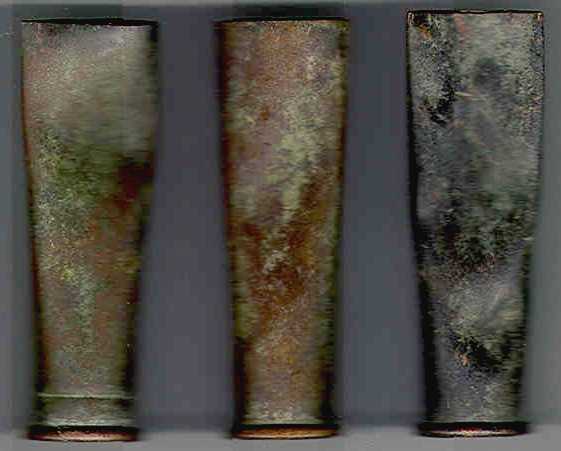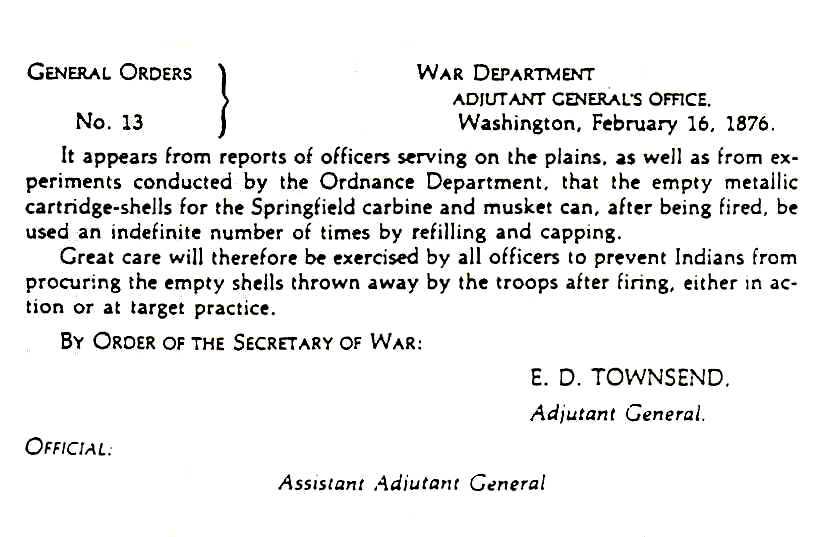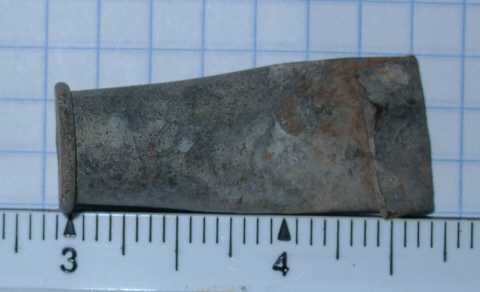| Contents
Home
General
Info
Ordering
Info
Contact us
Cartridge
Lists
Patent &
Miscellaneous
US Rim Fire
US Center Fire
Pistol
US Center Fire US Rifle
Metric
British
Shotgun Shells
Pictures
Posters
Links to Other Sites
Cartridge Collectors Organizations:
IAA
ECRA
SAAACA
Auctions:
Auction
Arms
E-Bay
Ward's Collectibles
Sold USA
Books:
Armory
Publications
WCF Publications
Other Collectr's Sites:
Curtis Steinhauer
|
Home of the Old Ammo Guy's Virtual Cartridge
Trading Table
Picture
Page
April 2004
Just when you thought there weren't
any good ones left to find...

What could be a more fitting way to start out my April pictures than with
five of the super elusive 'Southern' Game Loads, a veritable Royal Flush
in the shotshell collecting field. Produced in extremely limited numbers,
these shells were intended for use on those critters that are considered
to be game animals (and for which old family recipes tend to be coveted)
only south of the Mason-Dixon line. The popularity of these shells far exceeded
the manufacturer's expectations, to the extent that they are almost unheard
of today. As a result, most seasoned shotshell collectors have doubted their
existence for years, brushing off any mention of the shells as folklore
and urban legend. This picture should cast any and all doubt aside,
providing the serious Game Load collector who has managed to hang onto his
sense of humor with five more holes to fill in his collection. Who
says there aren't any good ones left out there?
The 'rest of the story'. To avoid causing any confusion among
collectors, I need to say at this point that these shells are a product of
my overactive imagination - an April Fools grouping of Game Loads that never
existed. But you have to admit that the story seems plausible, and the
shells do look pretty convincing.
A great Phoenix box.....

On to more serious stuff. Here's a great old box of .38 long rimfire cartridges
made by the Phoenix Metallic Cartridge Company, sometime between about 1877
and 1891. The cartridges have a fairly distinctive flat nose, two groove
bullet, and a raised 'P' headstamp. While this box is in fairly rough condition,
it should be noted that these boxes are pretty uncommon, and are seldom
found not showing a good amount of wear.
One man's trash is another man's
treasure....
 I often
receive e-mails from metal detectors and the occasional archeologist who
have found cartridge cases that they would like to have identified. More
often than not, these are the heads of old paper hulled shotgun shells, or
modern military or sporting cartridge cases. However, sometimes their finds
are quite interesting, such as the .45-70 cases shown in this picture, all
of which exhibit varying degrees of flattening. They were found in Eastern
Nebraska and, beginning with the Benet primed example on the left, were made
in 1880, 1883 and 1884. I had always assumed that the damage exhibited by
cartridge cases such as these was caused at some point after they were discarded,
either from having been stepped on by a person or a heavy hoofed animal,
or from being run over by a vehicle or a piece of farm machinery. While these
causes may account for some of the damaged cases found, the more likely cause
is that they were intentionally flattened, in accordance with military orders.
It had been found that Indians were reloading inside primed .45-70 and .50-70
cartridge cases that were discarded by the Army. This was accomplished by
inserting a percussion cap in a hole punched in the base of the copper case,
filling the case with black powder, and inserting either a newly cast or
a reclaimed bullet. In an effort to I often
receive e-mails from metal detectors and the occasional archeologist who
have found cartridge cases that they would like to have identified. More
often than not, these are the heads of old paper hulled shotgun shells, or
modern military or sporting cartridge cases. However, sometimes their finds
are quite interesting, such as the .45-70 cases shown in this picture, all
of which exhibit varying degrees of flattening. They were found in Eastern
Nebraska and, beginning with the Benet primed example on the left, were made
in 1880, 1883 and 1884. I had always assumed that the damage exhibited by
cartridge cases such as these was caused at some point after they were discarded,
either from having been stepped on by a person or a heavy hoofed animal,
or from being run over by a vehicle or a piece of farm machinery. While these
causes may account for some of the damaged cases found, the more likely cause
is that they were intentionally flattened, in accordance with military orders.
It had been found that Indians were reloading inside primed .45-70 and .50-70
cartridge cases that were discarded by the Army. This was accomplished by
inserting a percussion cap in a hole punched in the base of the copper case,
filling the case with black powder, and inserting either a newly cast or
a reclaimed bullet. In an effort to
 put an end
to this practice, the Secretary of War ordered that officers exercise 'great
care' to prevent Indians from procuring any empty cartridge cases that were
thrown away. This was General Order No. 13, issued February 16th, 1876, and
reproduced here. Apparently, one method adopted by the troops in the field
was to flatten the empty shells, perhaps with the butts of their
rifles, and then bury them all together in a single hole. Consequently,
rather than being found individually, these cartridge cases are usually found
in bunches. A lady recently sent me the picture of the put an end
to this practice, the Secretary of War ordered that officers exercise 'great
care' to prevent Indians from procuring any empty cartridge cases that were
thrown away. This was General Order No. 13, issued February 16th, 1876, and
reproduced here. Apparently, one method adopted by the troops in the field
was to flatten the empty shells, perhaps with the butts of their
rifles, and then bury them all together in a single hole. Consequently,
rather than being found individually, these cartridge cases are usually found
in bunches. A lady recently sent me the picture of the
 cartridge case
shown here, which was found near Rath City, Texas, a ghost town in the western
part of the state. From 1876 through 1879, this area was a center
for buffalo hunting, and she thought this cartridge case may have been used
by one of those hunters. Those who hunted for their livings tended to be
a frugal lot, who saved and reloaded their cartridge cases. This is
an externally primed case, and was intended to be loaded a number of times,
so it is not likely that a buffalo hunter would have thrown it away after
it was fired. The fact that the case has been flattened, and then had the
mouth folded over would indicate that the person who fired it was intent
on ensuring that it would no longer be serviceable. For this reason,
I believe this cartridge case was used by a soldier who was cognizant of
General Order No. 13 and fully understood its intent. cartridge case
shown here, which was found near Rath City, Texas, a ghost town in the western
part of the state. From 1876 through 1879, this area was a center
for buffalo hunting, and she thought this cartridge case may have been used
by one of those hunters. Those who hunted for their livings tended to be
a frugal lot, who saved and reloaded their cartridge cases. This is
an externally primed case, and was intended to be loaded a number of times,
so it is not likely that a buffalo hunter would have thrown it away after
it was fired. The fact that the case has been flattened, and then had the
mouth folded over would indicate that the person who fired it was intent
on ensuring that it would no longer be serviceable. For this reason,
I believe this cartridge case was used by a soldier who was cognizant of
General Order No. 13 and fully understood its intent.
I have several extras of the Nebraska shells if anyone has any that they
wish to trade from other areas of the country.
|




 put an end
to this practice, the Secretary of War ordered that officers exercise 'great
care' to prevent Indians from procuring any empty cartridge cases that were
thrown away. This was General Order No. 13, issued February 16th, 1876, and
reproduced here. Apparently, one method adopted by the troops in the field
was to flatten the empty shells, perhaps with the butts of their
rifles, and then bury them all together in a single hole. Consequently,
rather than being found individually, these cartridge cases are usually found
in bunches. A lady recently sent me the picture of the
put an end
to this practice, the Secretary of War ordered that officers exercise 'great
care' to prevent Indians from procuring any empty cartridge cases that were
thrown away. This was General Order No. 13, issued February 16th, 1876, and
reproduced here. Apparently, one method adopted by the troops in the field
was to flatten the empty shells, perhaps with the butts of their
rifles, and then bury them all together in a single hole. Consequently,
rather than being found individually, these cartridge cases are usually found
in bunches. A lady recently sent me the picture of the
 cartridge case
shown here, which was found near Rath City, Texas, a ghost town in the western
part of the state. From 1876 through 1879, this area was a center
for buffalo hunting, and she thought this cartridge case may have been used
by one of those hunters. Those who hunted for their livings tended to be
a frugal lot, who saved and reloaded their cartridge cases. This is
an externally primed case, and was intended to be loaded a number of times,
so it is not likely that a buffalo hunter would have thrown it away after
it was fired. The fact that the case has been flattened, and then had the
mouth folded over would indicate that the person who fired it was intent
on ensuring that it would no longer be serviceable. For this reason,
I believe this cartridge case was used by a soldier who was cognizant of
General Order No. 13 and fully understood its intent.
cartridge case
shown here, which was found near Rath City, Texas, a ghost town in the western
part of the state. From 1876 through 1879, this area was a center
for buffalo hunting, and she thought this cartridge case may have been used
by one of those hunters. Those who hunted for their livings tended to be
a frugal lot, who saved and reloaded their cartridge cases. This is
an externally primed case, and was intended to be loaded a number of times,
so it is not likely that a buffalo hunter would have thrown it away after
it was fired. The fact that the case has been flattened, and then had the
mouth folded over would indicate that the person who fired it was intent
on ensuring that it would no longer be serviceable. For this reason,
I believe this cartridge case was used by a soldier who was cognizant of
General Order No. 13 and fully understood its intent.